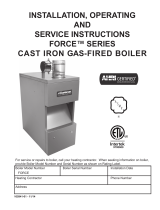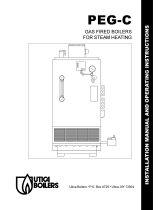
5
WARNING
Be sure to provide enough fresh air for combustion. Enough
air insures proper combustion and assures that no hazard
will develop due to the lack of oxygen.
You must provide for enough fresh air to assure proper combustion. The
fire in the boiler uses oxygen. It must have a continuous supply. The air in
a house contains only enough oxygen to supply the burner for a short
time. Outside air must enter the house to replace that used by the burner.
Study following examples 1 and 2 to determine your fresh air requirements.
EXAMPLE 1: Boiler Located in Unconfined Space
An unconfined space is defined as a space whose volume is not less
than 50 cubic feet per 1,000 Btu per hour of the total input rating of all
appliances installed in that space.
If your boiler is in an open area (unpartitioned basement) in a
conventional house, the air that leaks through the cracks around doors
and windows will usually be adequate to provide air for combustion.
The doors should not fit tightly. Do not caulk the cracks around the
windows.
Equipment located in buildings of unusually tight construction shall be
provided with air for combustion, ventilation, and dilution of flue gases
using the methods described in example 2B or shall be specially
engineered. The authority having jurisdiction must approve specially
engineered installations.
EXAMPLE 2: Boiler Located in Confined Space
A. All Air from Inside the Building: The confined space shall be
provided with two permanent openings communicating directly with
an additional room(s) of sufficient volume so that the combined
volume of all spaces meets the criteria for an unconfined space.
The total input of all gas utilization equipment installed in the
combined space shall be considered in making this determination.
Each opening shall have a minimum free area of one square inch
per 1,000 Btu per hour of the total input rating of all gas utilization
equipment in the confined space, but not less that 100 square
inches. One opening shall be within 12 inches of the top and one
within 12 inches of the bottom of the enclosure. The minimum
dimension of air openings shall not be less than 3 inches.
B. All Air from Outdoors: The confined space shall communicate
with the outdoors in accordance with methods 1 or 2. The minimum
dimension of air openings shall not be less than 3 in. Where ducts
are used, they shall be of the same cross-sectional area as the
free area of the openings to which they connect.
1. Two permanent openings, one commencing within 12 inches of
the top. and one commencing within 12 inches of the bottom,
of the enclosure shall be provided. The openings shall
communicate directly, or by the ducts, with the outdoors or
spaces (crawl or attic) that freely communicate with the outdoors.
a) Where directly communicating with the outdoors or where
communicating to the outdoors through vertical ducts. each
opening shall have a minimum free area of 1 sq. in. per 4000
Btu per hour of total input rating of all equipment in the enclosure.
(See Figure 3B)
b) Where communicating with the outdoors through horizontal ducts.
each opening shall have a minimum free area of 1 sq. in. per
2000 Btu per hour of total input rating of all equipment in the
enclosure. (See Figure 38.)
Fresh Air for Combustion
NOTE
If you use a fireplace or a kitchen or bathroom exhaust fan,
you should install an outside air intake. These devices will
rob the boiler and water heater of combustion air.
2. One permanent opening commencing with 12 inches of
the top of the enclosure, shall be permitted where the
equipment has clearance of at least 1 inch from the sides
and back and 6 inches from the front of the appliance. The
opening shall directly communicate with the outdoors or
shall communicate through a vertical or horizontal duct to
the outdoors or spaces (crawl or attic) that freely
communicate with the outdoor, and shall have a minimun
free area of:
a) 1 sq. inch per 3000 Btu per hour of the tatal input of all
equipment located in the enclosure ( See Figure 4), and
b) Not less than the sum of the areas of all vent connectors
in theconfined space.
Provision for combustion and ventilation air must be in accordance with Section 5.3, Air for Combustion and Ventilation,
of the National Fuel Gas Code, ANSI Z223.1-latest revision, or applicable provisions of the local building codes.
100% Free 75% Free 25% Free
Area Area Area
Fresh Air ¼" Wire Metal Wood
Duct Size Mesh Louvers Louvers
3" x 12" 144,000 108,000 36,000
8" x 8" 256,000 192,000 64,000
8" 12" 384,000 288,000 96,000
8½" x 16" 512,000 384,000 128,000
1 Square Inch per 4,000 Btuh
100% Free 75% Free 25% Free
Area Area Area
Fresh Air ¼" Wire Metal Wood
Duct Size Mesh Louvers Louvers
3" x 12" 72,000 54,000 18,000
8" x 8" 128,000 96,000 32,000
8" 12" 192,000 144,000 48,000
8½" x 16" 256,000 192,000 64,000
1 Square Inch per 2,000 Btuh
100% Free 75% Free 25% Free
Area Area Area
Fresh Air ¼" Wire Metal Wood
Duct Size Mesh Louvers Louvers
3" x 12" 108,000 81,000 27,000
8" x 8" 192,000 144,000 48,000
8" 12" 288,000 216,000 72,000
8½" x 16" 384,000 288,000 96,000
1 Square Inch per 3,000 Btuh
Figure 3A - FRESH AIR DUCT CAPACITIES (Btuh)
Figure 3B - FRESH AIR DUCT CAPACITIES (Btuh)
Figure 4 - FRESH AIR DUCT CAPACITIES (Btuh)






















